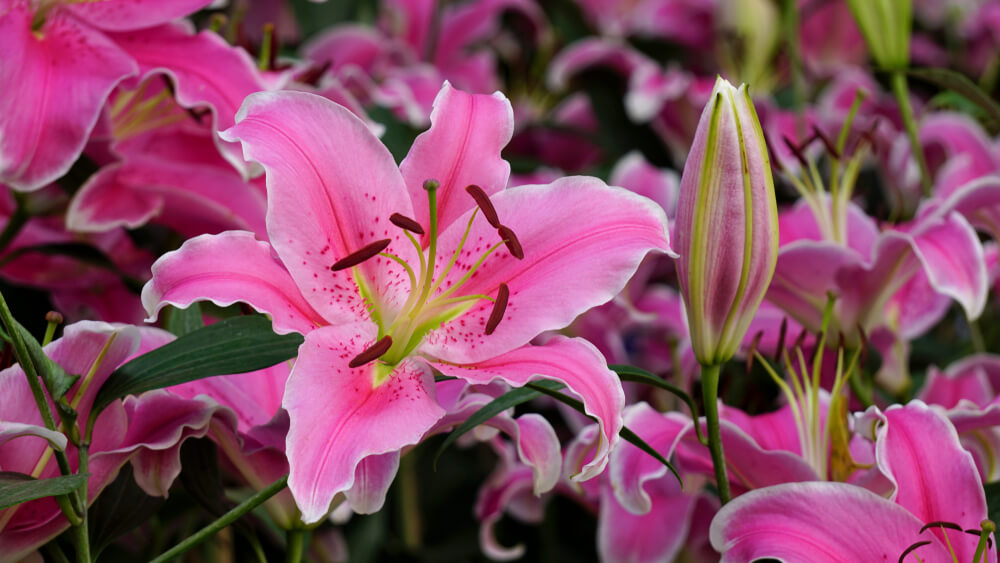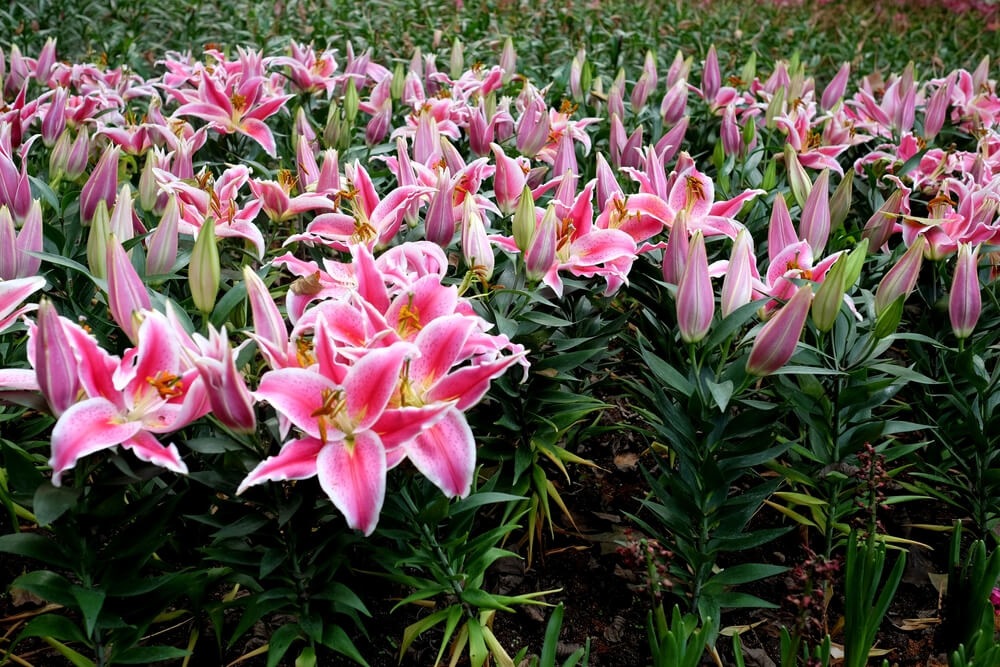
The Stargazer Lily, a captivating member of the oriental lily family, is renowned for its striking beauty and delightful fragrance. As one of the most popular lily varieties, it has become a favorite among gardeners and florists alike. The name “Stargazer” aptly describes the upward-facing blooms that seem to gaze at the stars, setting them apart from other lilies with downward-facing flowers.
One of the defining flower characteristics of Stargazer Lilies is their vibrant pink petals adorned with white edges and speckled with dark spots. This bold coloration makes them an eye-catching addition to any garden or floral arrangement. Beyond their visual appeal, these lilies are also celebrated for their intoxicating scent, which can fill a room with a sweet aroma.
Stargazer Lily facts reveal that they were first cultivated in 1974 by horticulturist Leslie Woodriff as a hybrid designed to combine the best traits of oriental lilies. They thrive in well-drained soil and prefer full sun to partial shade, making them relatively easy to grow for those looking to add an exotic touch to their outdoor spaces.
Whether you’re cultivating them in your garden or incorporating them into bouquets, Stargazer Lilies offer both aesthetic appeal and olfactory delight, making them a cherished choice among flower enthusiasts worldwide.
Ideal Growing Conditions for Stargazer Lilies

Stargazer lilies are a stunning addition to any garden, and understanding their ideal growing conditions can help them thrive. These vibrant flowers flourish best in well-drained soil that is rich in organic matter, making soil requirements a crucial consideration for optimal growth. Amending the soil with compost or peat moss can enhance its texture and nutrient content, providing the perfect environment for these lilies.
Sunlight needs are another important factor; stargazer lilies require full sun to partial shade to produce their characteristic large blooms. Ideally, they should receive at least six hours of direct sunlight each day. However, in regions with particularly intense afternoon sun, a bit of shade can help prevent scorching.
When it comes to plant hardiness zones, stargazer lilies are quite adaptable and can be successfully grown in USDA zones 4 through 9. This range allows them to withstand various climate conditions while maintaining their beauty across different regions.
Temperature tolerance is also significant for these plants. Stargazer lilies prefer moderate climates but can tolerate cooler temperatures as long as they are not subjected to prolonged freezing conditions without adequate protection such as mulching.
By paying attention to these key factors, you can create an environment where your stargazer lilies will not only survive but truly thrive.
Step by Step Instructions for Planting Stargazer Lily Bulbs
Stargazer lilies are a stunning addition to any garden, with their vibrant colors and intoxicating fragrance. To ensure your lilies thrive, it’s important to follow proper planting techniques. Here’s a step-by-step guide on how to plant lilies successfully.
First, choose the right planting season for lilies. Stargazer lily bulbs should ideally be planted in the fall or early spring when the soil is workable and not frozen. This timing allows the bulbs to establish roots before blooming.
Next, prepare your garden bed by selecting a location that receives ample sunlight and has well-drained soil. Lilies prefer full sun but can tolerate partial shade.
When it comes to bulb planting depth, dig holes that are about 6-8 inches deep. This depth provides enough coverage for the bulb while allowing room for root growth. Place each bulb with its pointed end facing upwards in the hole.
Spacing between bulbs is crucial for healthy growth and adequate air circulation. Space each bulb approximately 8-12 inches apart from one another. This spacing ensures that each lily has enough room to grow without competing for nutrients or space.
After placing the bulbs in their respective holes, cover them with soil and water thoroughly to help settle them into place. Adding a layer of mulch can also help retain moisture and regulate soil temperature as your lilies begin to grow.
By following these simple steps on how to plant lilies correctly, you’ll be well on your way to enjoying beautiful blooms throughout the growing season!
Caring for Your Stargazer Lilies (Watering and Fertilization Tips)
Caring for your Stargazer lilies involves understanding their specific watering and fertilization needs to ensure vibrant blooms. Establishing a consistent watering schedule for lilies is crucial, as these plants thrive in moist but well-drained soil. It’s best to water them deeply once a week, allowing the top inch of soil to dry out between waterings. This approach helps prevent overwatering, which can lead to root rot.
When it comes to fertilization, selecting the best fertilizer for lilies is key to meeting their nutrient needs. Stargazer lilies benefit from a balanced, slow-release fertilizer applied in early spring as they begin to grow. Look for a fertilizer with equal parts nitrogen, phosphorus, and potassium (such as 10-10-10) or one slightly higher in phosphorus to promote strong root and flower development.
Throughout the growing season, supplement with a liquid fertilizer every four weeks if needed. Pay attention to the nutrient needs of stargazer lily plants by observing their growth; yellowing leaves may indicate a lack of nutrients or improper pH levels in the soil. By tailoring your care routine with these tips in mind, you can enjoy healthy and stunning Stargazer lily blooms year after year.
Pest and Disease Management in Stargazer Lilies
Pest and disease management is crucial for maintaining the health and beauty of Stargazer lilies. Understanding lily pests identification is the first step in protecting these stunning flowers. Common pests include aphids, which can cluster on stems and leaves, causing deformities, as well as spider mites that create webbing and stippling on foliage. Early detection through regular inspection helps prevent significant damage.
In addition to pests, common diseases in lilies such as Botrytis blight can affect their growth. This fungal disease manifests as brown spots on leaves and petals, often thriving in humid conditions. Proper air circulation around plants and removing infected plant material promptly are effective preventive measures.
For pest control methods for flowers like Stargazer lilies, consider both chemical and organic solutions. Insecticidal soaps or neem oil sprays offer eco-friendly options for managing aphids and spider mites without harming beneficial insects. For more severe infestations or persistent diseases, targeted fungicides may be necessary but should be used judiciously to minimize environmental impact.
By staying informed about potential threats and employing proactive strategies, gardeners can ensure their Stargazer lilies remain vibrant and healthy throughout the growing season.
Pruning and Deadheading Techniques to Encourage Blooming
Pruning and deadheading are essential techniques for maintaining the health and beauty of your garden, especially when it comes to encouraging vibrant blooms. Proper bloom maintenance not only enhances the aesthetic appeal of your plants but also promotes healthier growth and more abundant flowering.
To start, let’s delve into pruning techniques for healthy growth. Pruning involves removing specific parts of a plant, such as branches or stems, to improve its structure and encourage new growth. It’s important to use clean, sharp tools to make precise cuts just above a node or bud. This encourages the plant to produce new shoots that will eventually bear flowers. Regular pruning helps prevent diseases by improving air circulation within the plant canopy.
Deadheading is another crucial technique that focuses on removing spent flowers from plants like lilies. Knowing how to deadhead lilies correctly can significantly impact their blooming cycle. After a lily flower fades, simply snip off the flower head just below the base where it meets the stem. This prevents seed formation and redirects energy back into producing more blooms rather than seeds.
By incorporating these bloom maintenance tips into your gardening routine, you’ll be well-equipped to foster a thriving garden full of colorful blossoms throughout the growing season. Whether you’re tackling lilies or other flowering plants, consistent pruning and deadheading will ensure your garden remains lush and vibrant year after year.
Troubleshooting Common Problems with Stargazer Lilies
Stargazer lilies are renowned for their striking beauty and fragrance, but like any plant, they can encounter a few common problems that require attention. Understanding the causes and solutions for issues such as wilting leaves, poor blooming, and yellowing leaves can help you maintain the health of your lilies.
Wilting leaves often indicate an issue with watering. Stargazer lilies need well-drained soil to thrive; overly saturated soil can lead to root rot. To remedy this, ensure your lilies are planted in a location where excess water can easily drain away. Adjusting your watering schedule to allow the top inch of soil to dry out between waterings can also prevent wilting.
Poor blooming in stargazer lilies may be attributed to insufficient sunlight or nutrient deficiencies. These plants flourish in full sun, so make sure they receive at least six hours of direct sunlight daily. Additionally, feeding them with a balanced fertilizer during the growing season will provide essential nutrients that support robust blooms.
Yellow leaves on stargazers could be a sign of several underlying issues such as overwatering or nutrient imbalance. If overwatering is not the cause, consider testing your soil’s pH levels; stargazers prefer slightly acidic to neutral pH levels (6.0-7.0). Amending the soil with appropriate nutrients or adjusting watering habits usually resolves this issue effectively.
The Best Companion Plants for Stargazers in Your Garden Landscape
When designing a garden landscape that features the stunning Stargazer lilies, incorporating companion plants can elevate both the aesthetic appeal and health of your garden. Companion planting offers numerous benefits, such as pest control, improved plant growth, and efficient use of space. To make the most of these advantages while complementing your Stargazers, consider integrating plants that thrive alongside them.
One popular choice for companion planting with Stargazers is lavender. Not only does lavender add a beautiful contrast with its purple blooms and silvery foliage, but it also repels pests like aphids and moths that might otherwise damage your lilies. Another excellent option is yarrow; its feathery leaves provide a textural contrast to the broad leaves of lilies and attract beneficial insects such as ladybugs.
For those looking to add more color diversity to their garden design ideas with lilies, consider planting coneflowers or black-eyed Susans nearby. These vibrant flowers not only enhance the visual appeal but also share similar sunlight and soil preferences with Stargazers. Additionally, their sturdy stems can offer some support to taller lily varieties during windy conditions.
Incorporating these companion plants into your garden not only enhances its beauty but also promotes a healthier ecosystem for your beloved Stargazers to flourish in. By understanding what grows well with stargazers, you can create a harmonious and thriving garden landscape that delights all who visit it.
Enjoying Beautiful Blooms from Healthy Stargazers
In conclusion, cultivating healthy Stargazer lilies is a rewarding endeavor that brings the beauty of their stunning blooms into your garden and home. These vibrant flowers, known for their striking appearance and delightful fragrance, thrive when given the proper care and attention. By ensuring they receive adequate sunlight, well-drained soil, and regular watering, you can enjoy an abundance of blossoms throughout the growing season.
Additionally, understanding the importance of deadheading spent flowers and protecting them from pests will help maintain their health and vigor. Whether you’re a seasoned gardener or just starting out, Stargazers offer an opportunity to enhance your gardening skills while enjoying the visual and aromatic benefits they provide.
By following these simple guidelines for care, you can ensure that your Stargazers flourish year after year, transforming any space into a colorful oasis. Embrace the joy of nurturing these beautiful blooms and savor the satisfaction they bring as they brighten your surroundings with their captivating presence.



